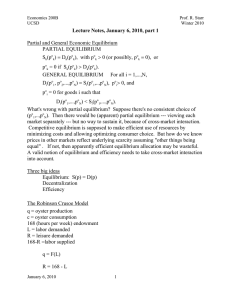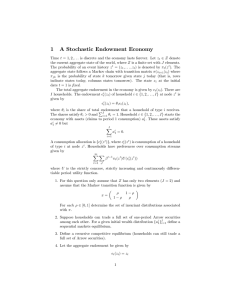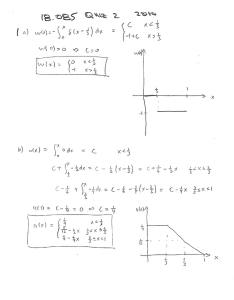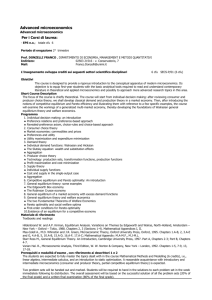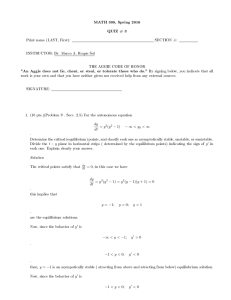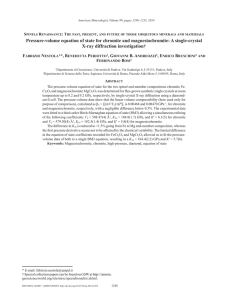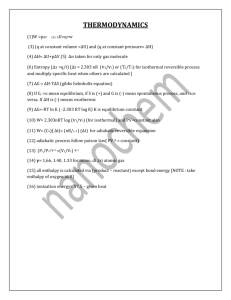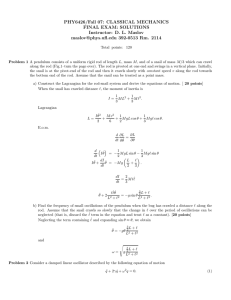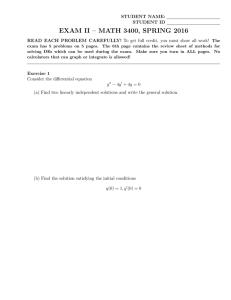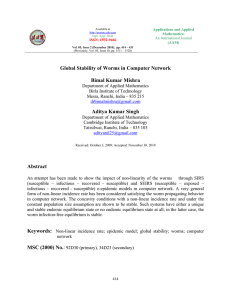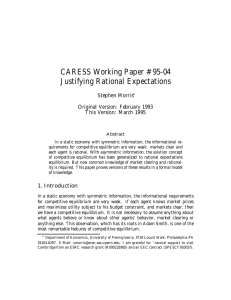Small Amplitude Fluctuations About Equilibrium
advertisement
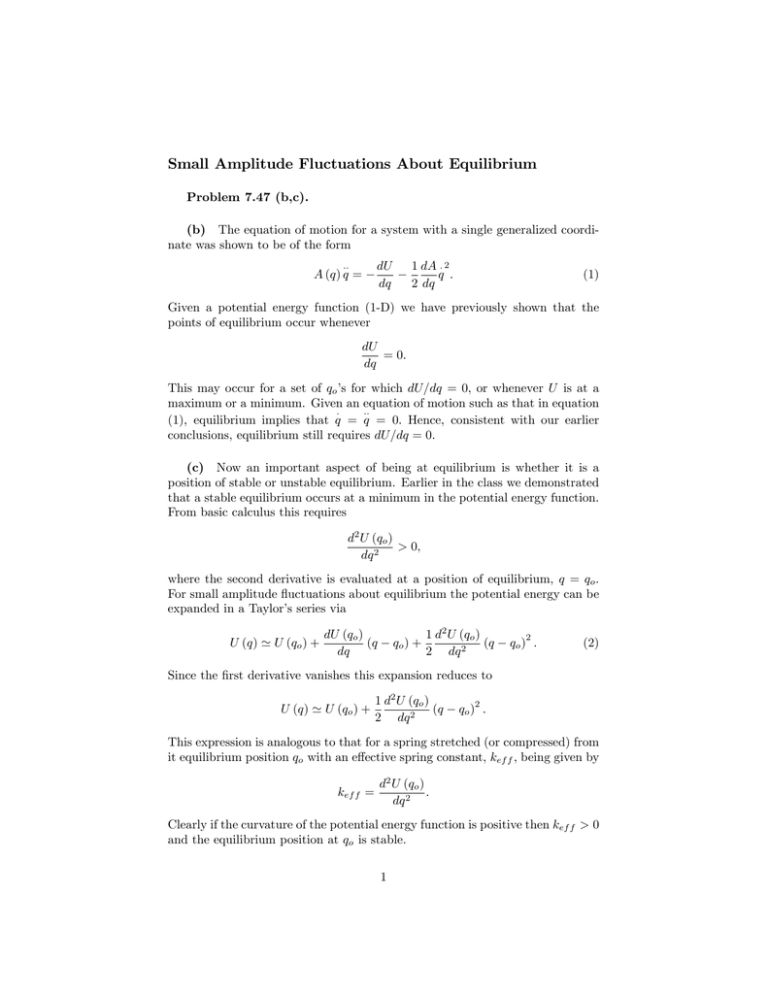
Small Amplitude Fluctuations About Equilibrium Problem 7.47 (b,c). (b) The equation of motion for a system with a single generalized coordinate was shown to be of the form A (q) q = dU dq 1 dA 2 q : 2 dq (1) Given a potential energy function (1-D) we have previously shown that the points of equilibrium occur whenever dU = 0: dq This may occur for a set of qo ’s for which dU=dq = 0; or whenever U is at a maximum or a minimum. Given an equation of motion such as that in equation (1), equilibrium implies that q = q = 0: Hence, consistent with our earlier conclusions, equilibrium still requires dU=dq = 0: (c) Now an important aspect of being at equilibrium is whether it is a position of stable or unstable equilibrium. Earlier in the class we demonstrated that a stable equilibrium occurs at a minimum in the potential energy function. From basic calculus this requires d2 U (qo ) > 0; dq 2 where the second derivative is evaluated at a position of equilibrium, q = qo : For small amplitude ‡uctuations about equilibrium the potential energy can be expanded in a Taylor’s series via U (q) ' U (qo ) + dU (qo ) (q dq qo ) + 1 d2 U (qo ) (q 2 dq 2 2 qo ) : (2) Since the …rst derivative vanishes this expansion reduces to U (q) ' U (qo ) + 1 d2 U (qo ) (q 2 dq 2 2 qo ) : This expression is analogous to that for a spring stretched (or compressed) from it equilibrium position qo with an e¤ective spring constant, kef f ; being given by kef f = d2 U (qo ) : dq 2 Clearly if the curvature of the potential energy function is positive then kef f > 0 and the equilibrium position at qo is stable. 1 Now consider the equation of motion, equation (1), for small amplitude ‡uctuations from equilibrium. In that case q = qo + ; where is small. Since qo is a constant the equation of motion is linearized and reduces to A (qo ) = dU (q) dq :: (3) q=qo + To determine the quantity dU (q) dq q=qo + for small we could simplify di¤erentiate the Taylor’s expansion, equation (2), above. However it is straightforward to note that a …rst order Taylor’s expansion of dU=dq about qo yields dU (q) dq = q=qo + dU (qo ) d2 U (qo ) + (q dq dq 2 qo ) = d2 U (qo ) : dq 2 Substituting this result into the equation of motion for small amplitude ‡uctuations, equation (3), yields d2 U (qo ) : dq 2 A (qo ) = (4) This equation is analogous to Hook’s law and harmonic oscillations occur as long as the curvature of the potential energy function at the equilibrium position qo is greater than zero, kef f > 0: That is the forcing function on the right hand side is negative corresponding to a restoring force. The equation of motion has an additional property in that we can obtain the frequency of small amplitude oscillations. From equation (4) these are given by !2 = 1 d2 U (qo ) kef f = ; A (qo ) dq 2 mef f where the e¤ective mass is mef f = A (qo ) : So the analogy with Hook’s law is complete. For small amplitude oscillations about equilibrium the angular frequency is found from the e¤ective spring constant divided by the e¤ective mass. Problem 8.13(b,c) (b) Consider two orbiting particles of reduced mass the potential energy function which interact via 1 2 kr ; 2 where r is the relative distance between them. The e¤ective interaction for two orbiting particles is 1 L2 Uef f (r) = U (r) + : 2 r2 U (r) = 2 Their equilibrium position for a circular orbit is found from L2 = 0; ro3 dUef f (ro ) = kro dr which has a solution ro4 = (5) L2 : k (c) To determine frequency of small amplitude oscillations about ro ; we consider the equation of motion for the relative coordinate r= dUef f (r) : dr As we saw in the solution for 7.47, for small amplitude oscillations, r = ro + ; this becomes 2 dUef dUef f (ro + ) f (ro ) = : (6) = dr dr2 The curvature or second derivative of the potential energy function at equilibrium is 2 dUef L2 f (ro ) = k + 3 : dr2 ro4 From equation (5) we can substitute for k with the result. 2 dUef L2 L2 L2 f (ro ) = + 3 = 4 : dr2 ro4 ro4 ro4 First we note that this expression is positive de…nite, hence we must have a stable equilibrium with harmonic oscillations about equilibrium. Dividing equation (6) by the reduced mass yields = 2 1 dUef f (ro ) = dr2 4 L2 : 2 r4 o (7) Hence the frequency of radial oscillations is !r = 2 L ro2 Since the angular momentum for a circular orbit is L = ro2 ; we see that !r = 2 : This means that the period of radial oscillations and the orbital period are related via ang = 2 rad : Hence the orbit is closed. 3

